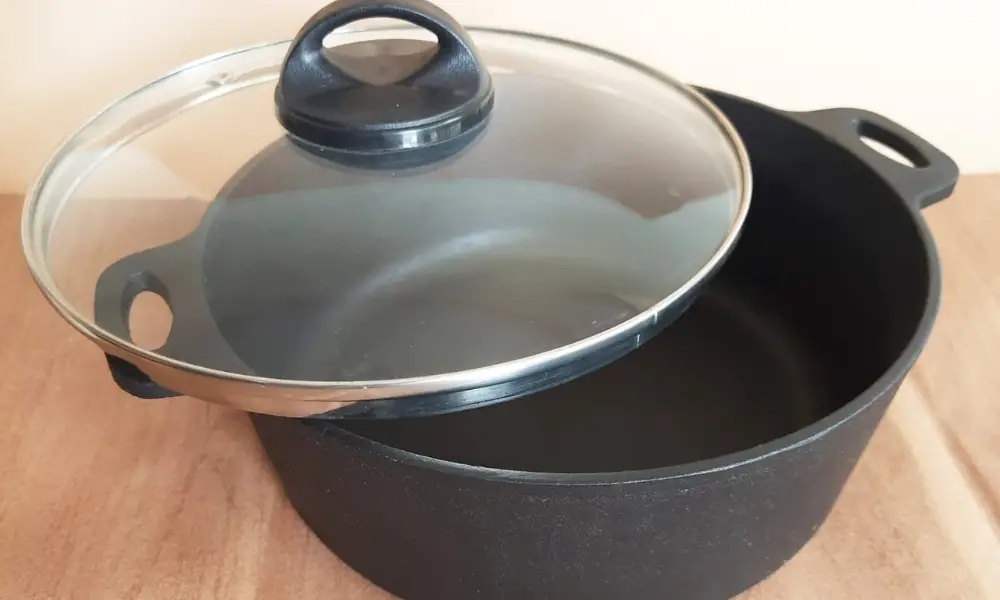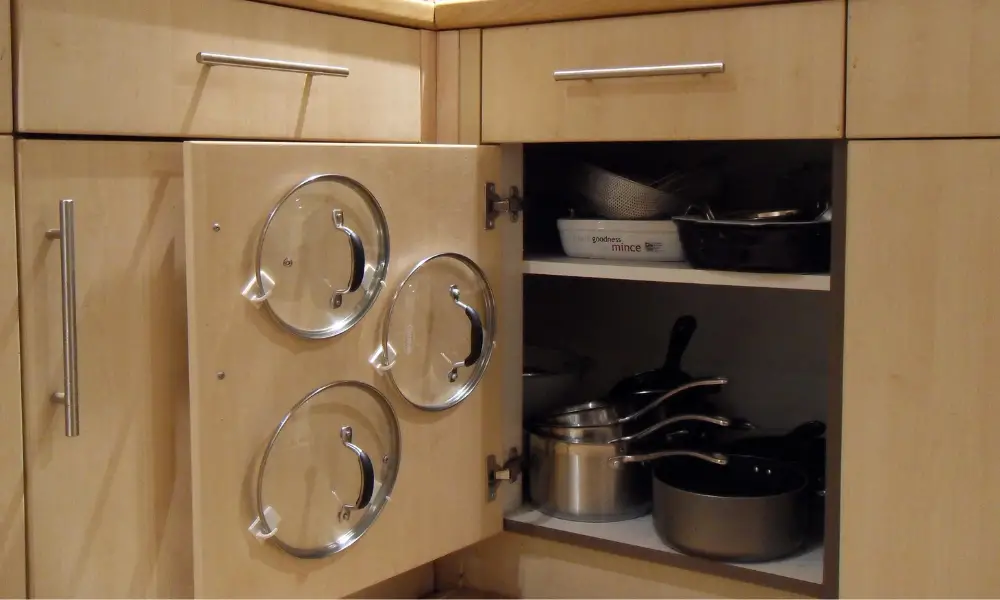One of the trickiest kitchen organizing puzzles to overcome can be where to put pot lids. They are all different sizes, can’t stand up by themselves, and when flat, take up too much valuable cabinet space. They cannot be stacked due to their knobs. Additionally, you shouldn’t store them on top of the corresponding pots because that can keep any moisture inside.
What options do you have then for deciding how to keep pot lids? It might be possible to set up a hanging S-hook arrangement if the lids’ handles have loops in them. If the lids have loop-less knobs, you can order an in-cabinet lid sorter or purchase a customized wall-mounted lid rack.
Alternatively, you could simply utilize a mail sorter and call it a day.

How to Store Pot Lids?
The most effective mail sorters have separators with varying heights.
Potlids of various sizes will be more effectively stored in a mail sorter like this one that has barriers that rise in height.
Your Pot Lids’ Depth should be Checked
Measuring the depth of your largest lid will help you select a mail sorter with slots that can fit it (excluding the handle). Since it is expected to sit higher than the sorter’s partition, the handle is unimportant.
Pick a Sorter with Some Weight at the Base
Pot lids are heavy, thus the sorter could collapse over if it were too light. By choosing a metal mesh mail sorter (like this one) and laying it against the internal wall of the cabinet, you can further eliminate the problem. (Alternatively, you may screw it into place by drilling a flat-head screw into each of the sorter’s four corners if you really want to ensure that it won’t move around.)
Verify that there are Sufficient Slots for All of your Pot Lids
You’ll probably need more than one sorter if you have more than three lids.
(Or, perhaps it’s time to scale back?) Grab a second sorter and set it on the cabinet’s opposite side.
Play around to find the best configuration for your particular pot lids.
Once you have your sorter, you might need to experiment to get your lids set up properly. If your lids have rounded domes, try positioning them so the handles point inward rather than outward.
How do I Measure the Size of the Lid?
A tight-fitting cover of a cooking pot enables optimal energy and time efficiency. The contents of the pot will cook more rapidly and evenly without heat leakage. A suitably sized cover is essential for dishes like rice since they must be kept at a moderate simmer for an extended amount of time without releasing steam.
Step 1
Put the pot on a level, flat surface.
Step 2
Starting from the inside of the rim and moving straight across the diameter, measure the pot’s rim. Take the last measurement from the pot’s rim’s exterior.
Step 3
Purchase a lid that corresponds to the pot’s diameter after noting the measurement.
What are the Different Types of Lids?
Screw Top Lid
Consumers are quite accustomed to and familiar with screw top lids. Screw-top lids are frequently used, whether on beverage bottles or jam jars. They are adaptable for many uses because they come in a variety of sizes and materials, like plastic or aluminum.
Screw-top lids are typically large and used on jars to store opulent cosmetic products or preserved foods. Screw-top lids are somewhat smaller when used on bottles and are frequently better for fizzy or alcoholic beverages.
There are additional variants that require the user to turn the lid while pressing down, making them child-resistant. These are advantageous for pill or prescription bottles that pose a risk to youngsters if left in plain sight.
Flip Top Lid
Flip-top lids contain one central hole for dispensing that is covered by the flip-top when not in use, despite typically having the screw-top lid mechanism to fix the lid onto the bottle.
Flip-top lids are compatible with a wide range of liquid and semi-liquid items, including oils, lubricants, and shampoos & conditioners. Flip-top lids provide the user control over how much product is dispensed, resulting in less product waste, thanks to the one, typically very small, dispensing hole.
Flip-top lids are frequently used on bottles or tubes that the consumer can squeeze to facilitate dispensing; it is unlikely that the product will easily dispense from sturdier bottles that the consumer cannot squeeze.
Sports Cap
While common for water bottles or energy drinks, a similar design can be applied to cosmetics like creams or hair products.
There are “open” and “closed” modes for sports caps and related styles. No product may exit when closed. When the lid is opened, the product might exit through the central area that is now visible.
What to do if a Pot Lid is Missing?
Everyone has said, “Ugggh, where’s the lid?” Is there any culinary tool as elusive to locate as the proper pot lid? It can be a great hassle to search through a cupboard for your stockpot or pan’s lid when you need to cover it, even if you’ve discovered a storage solution that makes sense for your lids. If you’re one of the fortunate few who has a universal lid and always knows where it is, try utilizing something else you already have on hand for those of us who hate the lid scramble.
Pan for Frying
Perhaps you’ve completed this task before. You can put a frying pan that is roughly the same size over the pot with ease. Although it won’t provide you with a very tight seal, if it is not essential to the meal you are making, you shouldn’t worry too much about it.
An Oven Sheet
Have access to a sheet pan? Simply place it atop the pot. Although a little bit heavier than a typical pot lid, it will work. It’s a tried-and-true restaurant and test kitchen trick for when the appropriate-sized lid isn’t accessible or doesn’t exist.
When you require a tighter fit than a sheet pan or frying pan would offer, a double sheet of foil works nicely as a cover. Although it’s a little trickier to work with than a lid, it traps heat and moisture just as well.
Parchment Paper
Even if you already have a lid, having parchment paper on hand will help you get a tight fit. Basically, you may cut a circle of parchment paper, place it on top of the dish you’re trying to cover, and bake it. This method works especially well with veggies that are sweating. The same circle can be placed underneath a regular pot lid to reduce moisture evaporation from your food as it cooks, such as during an extended braise in the oven.
Which Lid is Better: Glass Lid or Stainless Steel?
The decision is difficult. Because it has a high melting point (around 2500F), stainless steel is resistant to all the heat that your oven can generate. Depending on the handle and manufacturer, tempered glass typically peaks much lower. Even if the glass can withstand greater temperatures, the knob is typically not fastened very well and can only withstand temperatures of about 350 degrees Fahrenheit. However, depending on your demands, that might be sufficient.
In contrast, steel is opaque, making it impossible to see how a dish is doing unless you lift the lid, which cools the dish. Glass, on the other hand, is transparent, making it possible to theoretically see how a dish is doing via glass.
Glass really causes lids to fog up, although there are solutions, such as letting a lid fog up before swiftly opening and reopening it to shake down moisture.
Theoretically, simmering is better suited to glass lids. You’d imagine that glass lids would trap heat better than stainless steel ones since glass is a greater insulator than stainless steel. However, a lot of glass lids have steam vents, which tends to counteract the insulation benefit. Stainless lids typically lack steam vents since they are lighter than glass lids and will simply move slightly if the steam pressure becomes dangerously high, allowing a puff of steam to escape.
Conclusion
An accordion-style organizer is a great way to store pot lids in a small kitchen. This type of organizer can accommodate many different types of pots and lids. It can be hung from a bare wall or inside a cabinet door, and it has a unique design that accommodates lids of varying depths.
Potlids tend to be hard to organize. They are typically round with an extended handle. An accordion-style organizer is designed to accommodate any number of pot lids, including those that fit under the handle. This organizer is also durable enough to withstand heavier lids.
